It is difficult to find a gardener who does not grow tasty and very healthy raspberries on his plot. Well, if you are just planning to plant this fragrant berry, then this article is for you. Below, we will find out all the details of growing raspberry bushes and understand all the nuances of caring for this plant. Growing raspberries in the country is a rather laborious process, but at the same time very exciting, and most importantly, with proper care of this miracle plant, you can get a generous harvest.
Choosing a place for planting raspberries
It is important to understand that it is from the location of the raspberry plot that the amount of the crop depends, and how long this plant will live. Therefore, this issue must be approached with all responsibility.
Raspberry shrub, able to fully bear fruit for 11 years. Therefore, experienced gardeners recommend choosing a planting site along the hedge. The fact is that raspberries give a lot of shoots, and in this case this place will be ideal for her, especially if it is planned to grow in a bush way.
It should also be noted that this plant likes minimal slope and good drainage. In other words, soil into which moisture is poorly absorbed, completely unsuitable for growing raspberry bushes.
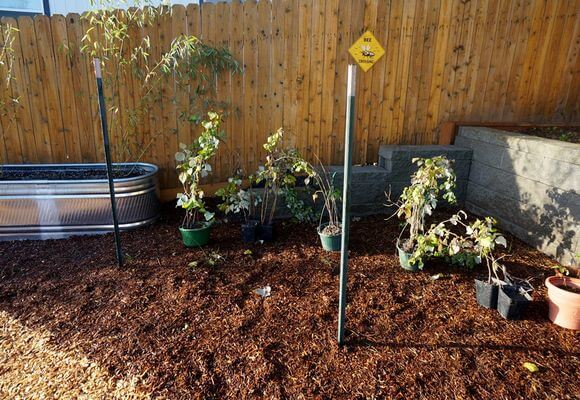
For this berry, the most dangerous is a strong excess of moisture, for this reason, planting sites where there are high chances of stagnant water should be excluded. It is also worth emphasizing that raspberries are a sun-loving crop, so if a summer resident plans to grow large-fruited raspberries, then darkened landing sites should be excluded.
Separately, it is worth adding that raspberry bushes do not like drafts; secluded places are more suitable for her.
And, of course, you should worry about the neighborhood. So, for raspberries, the best companion than fruit trees cannot be found, the main thing is that they do not shade the raspberries from the sun. But the currant will not become a good neighbor for raspberries, so you should not plant these two crops side by side, such a neighborhood will not work good harvest.
If you plan to grow raspberries in a greenhouse, then this structure must be placed in such a way that it is on the sunny side and outside the flood zone.
As soon as the issue of the location of the raspberry is resolved, it is necessary to prepare the soil for planting. As a rule, they begin to prepare the soil in the fall, performing the following manipulations:
- first dig the soil to a depth of 30 cm;
- the next step is the application of suitable fertilizers, such as rotted humus or compost;
- further, potash additives are added at the rate of 25 g per square meter.
In general, sandy clay or meadow soil, which is well saturated with useful elements, is ideal for raspberries. It is worth noting that clay soil or one that is oversaturated with limestone is not suitable for raspberries.
Growing Rules
Raspberry is not only delicious berry, it is simply unique in its composition, and most importantly, such a plant can be planted in almost any period, except for winter. But at the same time, landing should still be done in the fall. The fact is that it is during this period that such indicators as air temperature and moisture are the most optimal for its landing.
Well, if planting this berry does not work in the fall, then this procedure can be performed with the onset of spring. But at the same time, the main thing to consider is that they plant raspberries even before the moment when the plant wakes up and starts to bud.
In the event that the planting is delayed, then in the front garden where new bushes were dug in, snow melting should be delayed by simply sprinkling it with a large layer of sawdust.
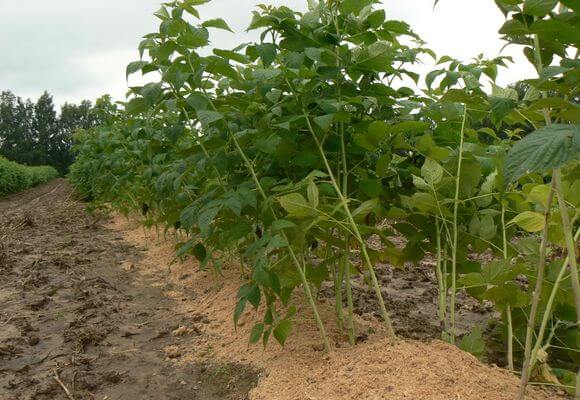
If it is necessary that raspberries be grown in the spring, then the soil for such a procedure is prepared in the fall. And if the planting material will be planted in the fall, then the preparatory work begins a month before the landing.
In general, the technology for growing raspberries is quite simple, provided that the preparatory work is carried out correctly.
How to plant raspberry seedlings
How to grow raspberries the right way? There is nothing complicated in this matter, if you strictly follow a few rules, namely:
- as planting material, only those seedlings are selected that have a well-developed root system, with several strong shoots;
- before planting, it is necessary to dig a hole about 30 cm deep and about 50 cm wide;
- fertilizers must be applied to the prepared hole, provided that this procedure was forgotten during the preparatory work;
- with cuttings, it is necessary to evenly distribute all the roots along the bottom of the hole, and then fill and compact with soil;
- after planting the raspberry bushes, it is necessary to water them well, and when the soil shrinks after the first irrigation, you should refill the loose earth.
When the plant is planted and watered, it is necessary to mulch each bush with rotted manure mixed with peat, needles and compost. Such a measure will help protect the plant from weeds and increase their fruiting.
In the event that there is no mulch, then throughout the summer it is necessary to loosen the ground around each bush three times.
How to grow raspberries from seeds
Often many gardeners are interested in this issue. Proper cultivation from seeds begins with the collection of seed. To do this, it is necessary to select fully ripe berries, for these purposes you can even use overripe ones.
When the material is collected, juice is squeezed out of it through gauze, and the remaining gruel is poured warm water and mix well.
This procedure helps to identify low-quality seeds that will float up, they must be disposed of. And fertile seeds will settle to the bottom, which should be washed a couple more times with water and sent to dry. During the drying process, the gardener must ensure that the seed does not dry out.
If the seeds are planned to be planted in the spring, then they are stored in the refrigerator until the onset of the season. Well, if such a manipulation is carried out in the fall, then the seed material is planted in holes 3 cm deep, which should be sprinkled with a mixture of rotted manure and sand.
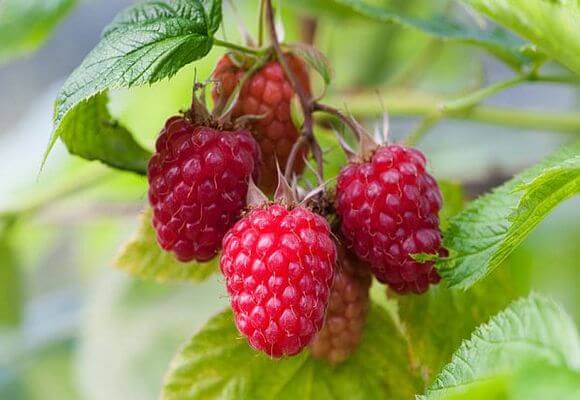
As for spring planting, it is better to grow seeds for seedlings in special containers, adhering to the following technology:
- the soil is prepared from sand, garden soil and peat, all components are taken in equal parts;
- sow the seed to a depth of 5 mm;
- every five days produce abundant watering;
- every ten days, the seeds are fed with a solution of urea.
With this approach, the chances of getting new raspberry sprouts become great. In general, many gardeners argue that getting new raspberry bushes from seeds is not only painstaking, but also ungrateful. Since there is a great risk of not getting new shoots at all.
How to grow raspberries on a trellis
Growing the most delicious and healthy berries on your own is not only a good thing, but also a profitable one. Given that all the costs incurred for such purposes will pay off with interest. And in order to take a generous harvest, you need to take care of such an important detail as growing raspberries on a trellis.
Of course, this method requires certain investments, but at the same time, such a device will make it much easier to achieve your goal in the form of a rich harvest.
If not provided for, this species will not have high fertility. Yes, and with a trellis it is much easier to care for plants. And in this case, only one question remains, which type of landing to prefer in order to choose the right support, namely:
- for shrubs that are located vertically, choose a trellis with a vertical plane;
- if there is no desire, you should give preference to a trellis that is vertically free, this method is perfect for bush planting;
- a horizontal trellis helps the raspberry to winter well;
- an inclined double-sided trellis is chosen when a raspberry uterine root is needed, for the subsequent production of full-fledged processes. With such a trellis, the branches in which it is planned to harvest are evenly distributed on both sides, and the middle is left for the growth of young shoots.
Many experienced gardeners recommend taking very seriously such an issue as the choice of material from which the trellis will be made in the future. The fact is that, for example, it provides for a metal frame, since this variety has rather large leaves and fruits, so the support must be strong.
In addition, it is worth noting that if the raspberry is still small in size, then wooden slats or any other material that can be found in the country can be used as a support.
How to care for raspberries
Regardless of how this crop is grown, in open ground or in a greenhouse, this most useful berry requires regular care during cultivation. As you know, absolutely every plant requires regular watering, and as for raspberries, this culture belongs specifically to moisture-loving shrubs.
Therefore, if a gardener wants to get a generous harvest from a raspberry front garden, then watering should be regular and generous. Especially when summer period was hot and dry.
But at the same time, it is necessary to ensure that the liquid does not stagnate on the ground, otherwise the cultivation of raspberries in the garden will end up with the roots dying.
In addition, when growing raspberries both in open ground and in greenhouses, you need to take care of the drainage system, which will help remove all excess moisture.
How to grow large raspberries, beginner gardeners often ask this question. It is not difficult to get a good harvest of large and fragrant raspberries if you follow all the rules for caring for this plant. And besides, this culture is not whimsical in care, so it will not be difficult to harvest a generous harvest.
The secrets of growing raspberries are proper watering and pruning. All the details regarding watering have been discussed above, so it is worth familiarizing yourself with such a procedure as pruning in more detail.
Raspberry bushes are known for their ability to actively expel new sprouts, which take away all useful substances from the main bush, as a result, this feature greatly affects the crop. Therefore, such uncontrolled growth must be restrained by pruning.
When new shoots appear that can adversely affect fruiting, they should be excised immediately. As for the branches that give the gardener a rich harvest, they should be cut immediately after harvest or in the spring.
It is also worth emphasizing that spring pruning it is also necessary to remove frozen and defective branches from the bush.
Raspberry cultivation features, as described above, is proper care. But at the same time, the correct pruning also depends on the type of raspberry bushes. If it grows on the site, then it should be cut in a different way.

Such a procedure is performed in the following way, after the harvest is harvested, the raspberry bush is cut out at the root. And with the onset of spring, the shrub will delight the gardener with new and strong stems. But at the same time, you need to monitor the number of pagons.
To date, the cultivation of raspberries according to the Sobolev method is very popular. It was he who first discovered that double pruning is the most effective. And it is performed as follows.
- The first pruning is carried out in May by 10 cm. Due to this, the lateral shoots begin to grow more intensively. And in the fall, you should definitely thin out the raspberry bush and leave no more than five pagons on it.
- The second stage of pruning is planned for next spring. It is performed in the same way as described above, but in parallel, frozen branches are also removed.
Growing raspberries involves regular loosening of the soil around the shrub. And in this case, it does not matter where the fragrant berry grows, in a greenhouse or in a garden. Such manipulation must be carried out very carefully so as not to damage the surface roots.
If the raspberry is placed in the front garden, then by winter the branches are bent into the ground, having previously tied them. This procedure is performed so that each bush is well sprinkled with snow, and thus protect the plant from death.
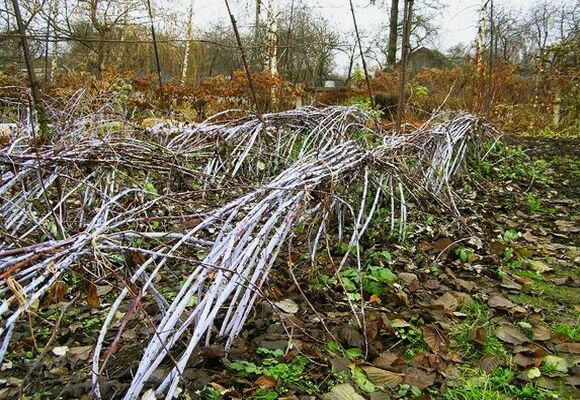
Separately, it is worth adding about such an important detail as plant nutrition. During the growing season, it is imperative to feed the shrubs. Such a procedure is performed according to the following scheme:
- before the appearance of fruits, organic and nitrogen fertilizers are introduced into the soil, but only in small quantities;
- when intensive fruiting occurs, it is necessary to make a little ammonium nitrate or superphosphate;
- when the crop is fully harvested on the raspberry plantation, it is necessary to fertilize the soil in which the shrub grows again with the help of potash additives and superphosphate.
Performing the procedure correctly, they will surely thank the gardener with a good harvest of large and sweet berries. In general, it is worth noting that the methods of growing raspberries do not differ much from each other.
The main thing is to create the right care for the plant, and in this case, the shrub will definitely please the harvest.
Conclusion
How to grow raspberries was described above, but the most important rule when growing such a crop is not to forget this in a timely manner, to carry out manipulations that will help get a good result.
Moreover, if the gardener decided to grow raspberries in greenhouse conditions, then you can achieve a harvest all year round. This method is ideal if you turn the cultivation of raspberries into a profitable business.
Well, in conclusion, I would like to add that in order to get a good harvest from a raspberry plantation, it is enough to devote just a little time to this crop. It's no secret that raspberry cultivation is quite simple. Therefore, we grow raspberries correctly and enjoy this fragrant and delicious sweetness.
Raspberries are one of the most valuable berries for summer residents and gardeners. How to grow raspberries correctly?
Many grow not only ordinary raspberries, but also remontant and raspberry-blackberry hybrids.
Like any other garden plant, it requires proper cultivation and careful care.
Growing a bush can seem like a daunting task for a beginner gardener.
Raspberry is a moisture-loving plant, its yield largely depends on sufficient and timely watering during flowering and before harvesting.
Growing raspberries in shady places, along fences, under trees is not the best option.
Growing a crop will become productive if you comply with a number of conditions:
Choose a well-lit area for planting.
The site should be well warmed up by the sun, but protected from the winds.
The bush does not tolerate excessive moisture at all. He does not like even a short-term flooding.
If you plant raspberries in a damp area, then in winter it can freeze.
Culture prefers highly fertile soil.
The best soil is medium drained loam.
If you grow raspberries on sandy soil, then abundant application of organic fertilizers to the soil is necessary.
Timely watering is especially important.
Yields with a lack of moisture during
the formation of berries is reduced by 3 times.
Seedlings can be planted both in spring and autumn. But the soil is prepared in advance, at least two to three weeks before planting.
If spring planting is planned, then it is better to prepare the place in the fall.
There are two ways to land.
At the first, they are planted in separate holes and the plant is grown in the form of shrubs of 8-10 stems.
The second method is to plant seedlings in a trench in one row.
Bushes can grow and bear fruit well for 10 years in one place. Close attention is paid to preparing the soil mixture for planting.
It is prepared from equal parts of the removed top fertile layer, rotted manure and matured compost.
Be sure to enrich the mixture mineral fertilizers. very good to use double superphosphate And wood ash.
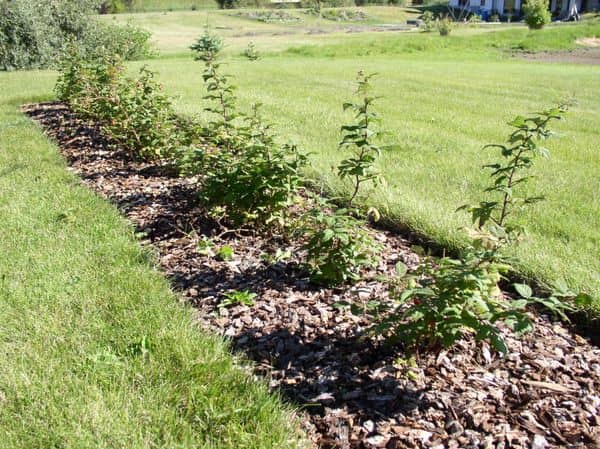
With a separate planting method, planting pits are dug 0.5 x 0.5 m in size.
The mixture is poured onto the drainage layer in the center of the pit, so that a small mound forms.
Before planting, the seedling is immersed in a mullein solution for several minutes, and then lowered into a hole on top of an earthen mound and the roots are carefully straightened.
Falling asleep roots, the soil is well compacted. When planting, do not bury the root neck, as the root bud can rot.
The optimal location of the root neck is at ground level or slightly higher.
With the trench method of planting, they dig a trench of the same width and depth as the planting pits.
They are located at a distance of at least 1 meter from each other, and between plants there should be at least 0.4 m.
At the end of planting, the seedlings are cut to a height of 0.3 m, watered and mulched.
As mulch, crushed peat, humus or, in extreme cases, dry earth is used.
As raspberries grow, the rhizomes release substances
which have a negative impact on young seedlings.
Therefore, planting raspberries in this place can not be earlier,
than seven years later.
Repair raspberries require a deeper planting.
With a horizontal arrangement of seedlings in the hole and complete cutting of the aerial part after sprinkling with nutrient soil.
The rest of the planting points are the same as for ordinary raspberries.
So that future long stems do not break off and do not stagger from the wind, trellises are arranged.
Strong stakes or metal pipes are dug along the edges of the ridge, and a wire is pulled between them in two rows.
One row is located approximately 0.5 m from the ground, and the other - 0.7 m.
If the trench is long, then additional supports are driven in in the middle to prevent sagging of the wire.
As the shoots reach a sufficient height, they are tied to a wire, distributing fan-shaped.
To limit the growth of the root system, the trenches are fenced with a barrier of some kind of non-rotting material, digging it in to a depth of 30 - 35 cm.
Most gardeners use pieces of slate for this purpose. They also do with individual landings.
Raspberry rhizomes annually produce many offspring that can bear fruit the next year.
Low, neatly dug seedlings are used for shrub propagation.
Planting raspberries in autumn.
In autumn, the site begins to prepare a month and a half before planting.
The earth is dug up to the depth of a shovel bayonet, freeing from weeds and adding 2-3 buckets of rotted manure, 200-400 g of superphosphate and 100-200 g of potassium sulfate per 1 sq m - this dressing will allow you not to apply potash-phosphorus fertilizers to the soil for about five years.
The optimal time for landing is the end of September or the beginning of October.
Autumn planting is preferable to spring, because you can slowly and conscientiously prepare the site, and, in addition, before the onset of frost, the seedlings have time to take root, and in the spring they rapidly start to grow.
In early spring, on a fruit-bearing plantation (preferably before the soil thaws), an audit of the plantations is carried out.
Remove damaged and cut out weak stems, bushes are cut.
At the end of April, the first top dressing with nitrogen fertilizers and soil loosening are carried out, after which the site is immediately mulched with wet peat.
As soon as the soil thaws, trellises of the simplest design are installed on the plantation of young raspberries of the second year of planting.
At the edges of the rows, to a depth of 0.5 m, columns are buried one and a half meters high and at a height of up to one and a half meters.
2 rows of wire are pulled, to which the stems are tied in early spring, and the annual shoots that appear when they reach the appropriate height.
Care and cultivation of raspberries are moments that require special attention.

Use these recommendations to ensure a regular and rich harvest:
Raspberries need rare but plentiful irrigation. The soil should be moistened to a depth of about 30 cm.
In dry season, the bush is watered 1-2 times a week.
The soil must be constantly moist and loose. Weeding. The soil should be loosened regularly.
The procedure is carried out every time after watering (when the soil dries out).
However, during weeding, it is important not to damage the root system, so the loosening depth should be no more than 3-5 cm.
Even if you do not forget to periodically put mulch into the raspberries, fertilizing with organic fertilizers will not be superfluous, especially in the early years.
As spring feeding ideal infusion of bird droppings.
1 kilogram of litter should be insisted for a week in 10 liters of water, and then diluted with water 1:10 and feed the bushes.
Top dressing works even better, consisting of half manure infusion, half liquid fertilizer from grass.
Growing young shoots can be sprayed with a solution of EM preparations at intervals of two weeks.
Such spraying serves not only as a top dressing, but also as a disease prevention.
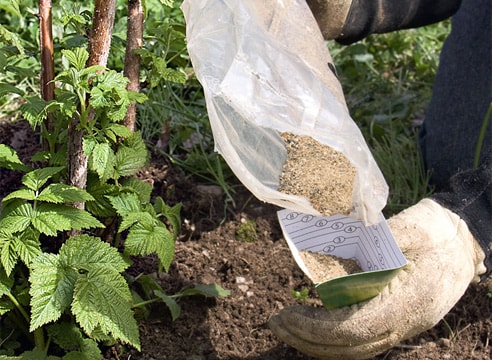
In autumn, you can prepare a special complex infusion for feeding.
To do this, the barrel is filled 2/3 with grass, weeds, hay or tops, one and a half glasses of ash, a handful of granulated manure, litter or biohumus, one and a half glasses of jam or sugar, 2 school crayons are added and poured with warm water.
To speed up fermentation, you can pour in a small amount of EM solution.
After 10 days, the infusion is ready. For top dressing, half a liter of such a fertilizer is diluted in ten liters of water.
If it is not possible to prepare a complex top dressing, it does not matter.
Use the good old ash infusion. To prepare it during the day, you need to insist 2 cups of ash in 10 liters of water.
Raspberries are fertilized by pouring 3 liters of liquid fertilizer under each bush.
As you have already seen, planting raspberries and caring for them is a simple matter.
Reproduction is just as easy, especially if you know how to do it.
We just told you about reproduction by offspring. Now we will tell you how to propagate raspberries by cuttings .
In June, in cloudy weather, from root offspring of two and three years of age, cut cuttings 10-12 cm long with two or three leaves, put them in a rooting stimulator for half a day, and then plant them in a half-liter container with a peat-sand mixture under a film keeping the temperature between 22-25 ºC and the humidity level around 90%. A month later, when the cuttings begin to grow, they are carefully transferred, together with an earthen clod, into a large container - at least 14 cm high and about one and a half liters in volume.
As soon as they take root, gradually begin to accustom them to the outside air, and when they adapt to the external environment, transplant them to the training garden, equipping the cuttings with shading until they get used to and begin to grow again.

Plant them out in the fall. If you cut the cuttings in the fall, treat them with a fungicide for fungal diseases, cover them with peat and place them in a basement, cellar or any other cool place for stratification until spring, periodically moistening the peat.
In the spring, plant the cuttings in the garden and mulch the soil around them.
There are types of raspberries that reproduce like blackberries - by rooting the tops.
These include chokeberry and purple.
When at the beginning of autumn the grown shoot begins to tend to the ground, the leaves at its top become smaller, and it itself takes the form of a loop - it is at this time that it needs to be rooted. Cut off such a shoot along with the “handle”, and you will get planting material that can be rooted using the method already described.
A mandatory stage of care is the seasonal pruning of raspberries. E
that is due to the fact that life cycle shoots is two years.
Then they die off, and new ones grow in their place.
If you do not remove the old shoots, they will interfere with the young ones, they will become carriers of diseases.
With timely pruning, you will get a high yield.
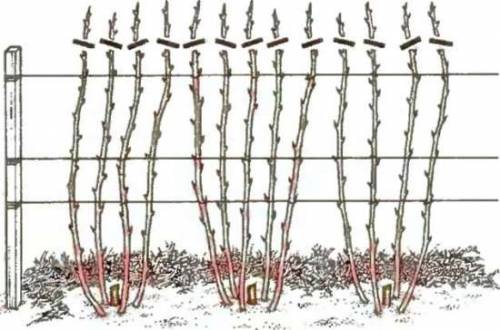
The pruning process is carried out both in spring and in summer and autumn.
In the spring, it is needed to stimulate the growth of raspberries. Spend it when the snow melts.
To do this, cut weak and damaged shoots closer to the ground with a sharp pruner.
In summer, it is necessary to cut off shoots that have already ended their life cycle.
To do this, stiff stems are cut at the very base.
In the autumn it is necessary to carry out sanitary pruning.
Cut off damaged and broken stems, as well as shoots that did not have time to gain strength.
The remaining branches are tied and bent down for wintering.
Raspberry cultivation and care. Video
Raspberries are extremely popular among Russian gardeners. This is due to its high taste qualities. This berry is good fresh, and in the form of jam or jam, and dried. The article will discuss the most popular varieties of raspberries and the proper care for them.
People have been cultivating raspberries since the Stone Age, as evidenced by its seeds found during excavations. The first mention of this plant growing in the wild dates back to the 1st century AD. It was well known to the Romans and Greeks of those times both as a delicious dessert and as a medicinal potion.
- Wild European red and American bristly raspberries have given impetus to the domestication of these species. In the 19th century, many varieties had already appeared in Europe.
- It has long been known and loved wild raspberries in Rus'. She served as an excellent delicacy and medicine. Berries and leaves were dried for the winter and teas rich in vitamins were prepared.
![]()
- By the beginning of the 19th century, only a few varieties of raspberries were grown in Russia. Huge selection work to expand the assortment was carried out in the 30s and 40s by scientists Soviet Union. High-quality domestic varieties were bred by Michurin I.V., Kuzmin N.V., Spirin V.V. and other famous breeders.
Culture Information
Rubusidaeus is the Latin name for the common raspberry.
- The plant is a perennial deciduous shrub growing up to 2.5 meters in height.
- Woody erect shoots bear fruit in the second year, and then die off. At the same time, new herbaceous shoots grow from the rhizomes, which subsequently become woody. However, in remontant varieties, first-year shoots are also able to bear fruit.
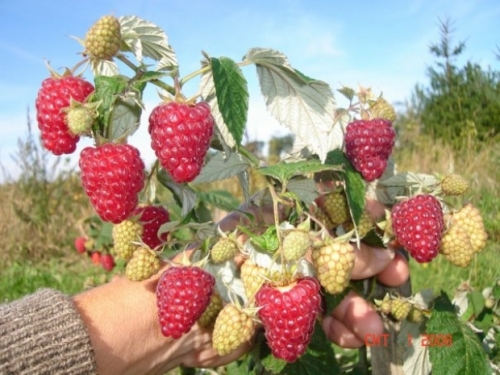
- Dark green leaves whitish underneath. They have a complex structure. They consist of several leaflets, serrated along the edges and slightly pubescent with small villi. A shrub blooms in mid-summer with racemose inflorescences. The berries are collected from fused small juicy drupes. Usually the fruits are burgundy, but there are varieties with yellow and even black berries.
- Berries contain - glucose, fructose, vitamins, organic acids. Due to the content of salicylic acid, raspberries are widely used as a diaphoretic for colds.
Raspberry cultivation
Location selection
- This shrub requires a sunny position, sheltered from the winds, and fertile, neutral to slightly acidic soil with good drainage.

- For a raspberry plant, a site located along the fence, or in the corner of the site, but not in its center, is suitable. Since this plant is capable of producing offspring from the roots, which can appear throughout the site at great distances from the main bush, including in flower beds and beds.
- Raspberries are very susceptible to bacterial canker, the bacteria of which can persist in the soil for several years. Therefore, it is important to know the state of previous crops in the area planned for raspberries.
Planting raspberries
- Raspberry seedlings can be planted both in spring and autumn. But in any case, the soil is prepared in advance, at least two to three weeks before planting. If spring planting is planned, then it is better to prepare the place in the fall.
- There are two ways to land. At the first, raspberries are planted in separate holes and the plant is grown in the form of shrubs of 8-10 stems. The second method is to plant seedlings in a trench in one row.
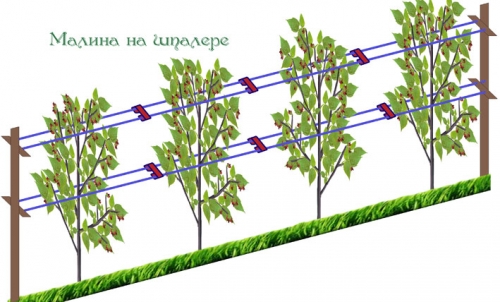
- Raspberry bushes can grow and bear fruit well for more than 10 years in one place. Therefore, close attention is paid to the preparation of the soil mixture for planting. It is prepared from equal parts of the removed top fertile layer, rotted manure and matured compost. Be sure to enrich the mixture with mineral fertilizers. It is very good to use double superphosphate and wood ash. It is better not to add nitrogen fertilizers, as this leads to poor rooting of seedlings.
- With a separate planting method, planting pits 0.5 x 0.5 m in size are dug. The mixture is poured onto a drainage layer in the center of the pit, so that a small mound is formed. Before planting, the seedling is immersed in a mullein solution for several minutes, and then lowered into a hole on top of an earthen mound and the roots are carefully straightened. Falling asleep roots, the soil is well compacted. When planting, do not bury the root neck, as the root bud can rot. The optimal location of the root neck is at ground level or slightly higher.
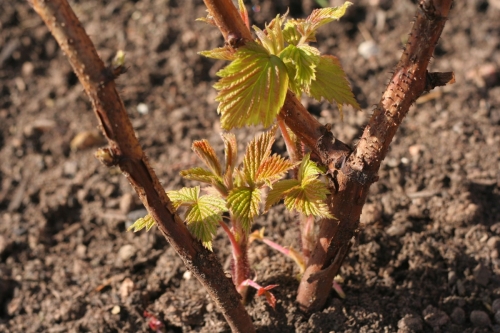
- With the trench method of planting, they dig a trench of the same width and depth as the planting pits. They are located at a distance of at least 1 meter from each other, and between plants there should be at least 0.4 m.
- At the end of planting, the seedlings are cut to a height of 0.3 m, watered and mulched. As mulch, crushed peat, humus or, in extreme cases, dry earth is used.
- Remontant raspberries require a deeper planting, with a horizontal arrangement of seedlings in the hole and complete cutting of the aerial part after sprinkling with nutrient soil. The rest of the planting points are the same as for ordinary raspberries.
- So that future long stems do not break off and do not stagger from the wind, trellises are arranged. Strong stakes or metal pipes are dug along the edges of the ridge, and a wire is pulled between them in two rows. One row is located approximately 0.5 m from the ground, and the other - 0.7 m. If the trench is long, then additional supports are driven in in its middle to avoid sagging wire. As the shoots reach a sufficient height, they are tied to a wire, distributing fan-shaped.
- To limit the growth of the root system, the trenches are fenced with a barrier of some kind of non-rotting material, digging it in to a depth of 30 - 35 cm. Most gardeners use pieces of slate for this purpose. They also do with individual landings.

- Raspberry rhizomes annually produce many offspring that can bear fruit the next year. Low, neatly dug seedlings are used for shrub propagation.
Raspberry care
- The plant especially needs water during periods when flowering and berry setting begin. Abundant watering is done 3-4 times during the summer, and more often in dry seasons. Moreover, it is necessary to water not only trenches, but also row-spacings, since the root system of the shrub grows widely. After watering, the soil is mulched with a thick layer that retains moisture. Although raspberries are moisture-loving, they should not be poured either. Otherwise, due to waterlogging, the root system will not receive enough oxygen and will slow down its development. Closer to autumn, watering is reduced.
- It is impossible to allow the raspberry tree to become overgrown with grass, which is a refuge for pests, makes it difficult to ventilate plantings, and takes food from the bush. At the same time, few young shoots appear, the quality and quantity of berries deteriorate significantly. Therefore, they not only weed the space between the bushes in trenches and planting pits, but also deeply hoe the aisles. This procedure is done several times during the season.
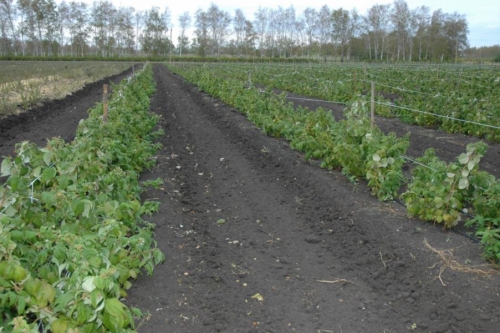
- If the soil was properly filled at planting, then no additional feeding is required in the first year. But then, in order to get guaranteed good yields, organic matter and mineral fertilizers are applied annually in early spring: about 15 g of complex fertilizers and 3-4 kg of manure per 1 sq. meter landing area.
- The second time they are fed during budding with potash and phosphorus fertilizers, in accordance with the recipe indicated on the package. The last top dressing is done in the fall after pruning, reducing the amount of fertilizer by one third.
- A few years later, in the event of a decrease in yields, they dig up old rhizomes without affecting the young shoots. Thus, the rejuvenation of the raspberry occurs.
- No matter how hardy the planted variety is, it still needs winter shelter, especially in regions with harsh winters. The snow serves as a cover. In late autumn, but not at negative temperatures, raspberry stalks are bent as close to the ground as possible and pinned with hooks made of hard wire or pressed with a heavy load. The plant should be completely covered with snow. In winters with little snow, snow is raked from other parts of the garden. It is impossible to take snow from row spacings in raspberries, as this will lead to freezing of the root system. After the spring melting of the snow cover, the hooks are removed and the stems unbend.
Raspberry pruning
- In early spring, the raspberries are thinned out, leaving up to 15 tall strong stems per 1 sq. meter. Sanitary pruning is carried out, cutting out frozen and broken stems.
- In traditional varieties, berries are formed on last year's stems, so they are cut out after picking the berries, trying not to leave stumps. This will serve as an incentive for the development of strong young shoots - the key to the next season's harvest. In young stems that remain for the winter, pinch the top, which accelerates their ripening. Also, plantings are regularly thinned out, removing underdeveloped growth that thickens the raspberries.
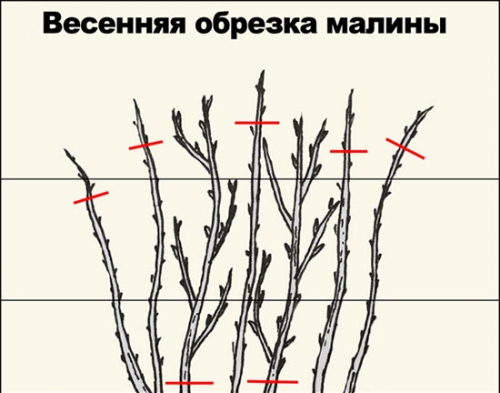
- Many amateur gardeners have recently used the double pruning method. The first pruning is done at the very beginning of summer, shortening the shoots by 8-10 cm. This stops the growth of the top and gives rise to the appearance of several lateral growths. The next spring, they make the same second pruning, but already side branches. It is with this second pruning that additional fruit branches are formed both on the central stem and on the lateral growths. Using this pruning method stretches the ripening time of the crop from July to September.
Fight against possible diseases and pests
Raspberries can be classified as tender crops, in the sense that they are often affected by various viral and fungal diseases, and many harmful insects are not averse to feasting on them. To protect the berry plant from these misfortunes, certain efforts are required from gardeners.
- Particular attention should be paid to the choice of seedlings, because many fungal diseases are transferred precisely with planting material. Seedlings should be purchased from trusted nurseries that can guarantee their healthy condition. From private individuals, you can easily buy raspberries infected bacterial cancer, anthracosis, didimela (blue-violet spotting) and other fungal diseases.
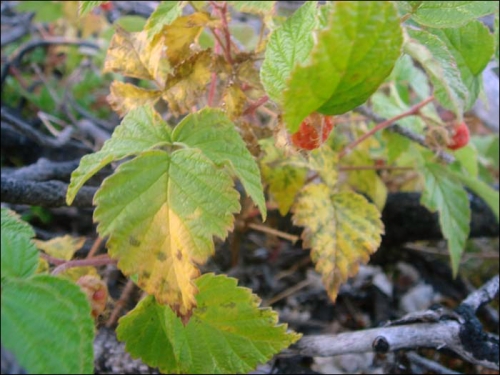
- Any chemicals apply before the shrub begins to bloom or after harvest. Fungal diseases are treated in early spring by spraying with compounds containing copper or Bordeaux liquid. To combat insects, biological products are used, which are widely represented in the trade. If you regularly inspect the plantings, then you can catch insect damage in the initial stages, then it may be possible to reduce the population by collecting them manually.
- Heavily infected shoots are immediately cut out and burned. The fallen autumn leaf is also burned, as pathogens and insect larvae find shelter in it. The soil between the stems is loosened, and the aisles are dug up.
- Of the viral diseases, the so-called witch's broom is common, in which the plant produces many thin, low shoots and becomes like a panicle. Raspberries are often attacked by yellow mosaic and other viral diseases. When plantings are infected, it is not necessary to count on a high yield. In order to stop the spread of diseases, infected bushes are uprooted. They also fight aphids and leafhoppers that carry viruses.
Popular raspberry varieties
- Harvest on vigorous stems of the variety "Bulgarian ruby" begins to ripen at the very end of June. Yields are stable. It has large dark red berries. Taste qualities good ones. Drought tolerance is poor.

- In the dessert variety "Abundant" bushes without thorns. The berries are very large, red, slightly elongated. They tolerate transportation well. The variety is disease and cold resistant.
- The variety has delicate and sweet elongated berries. Malakhovka. The yield is average. Berries are transportable. The shrub is resistant to spider mites, however, it is afraid of gray rot. Winter hardiness is weak, requires shelter.
- "Hussar" refers to winter-hardy and disease-resistant and drought-resistant varieties. Bright ruby berries have a conical shape. Shoots grow up to two meters in height. Yields are high and stable.
- Variety "Golden Giant" interesting in that it bears large yellow berries with good taste. The berries are strong, do not crumple during transportation. Bushes tall, upright. The variety is winter-hardy and disease-resistant. Below is a photo of a raspberry of this variety.
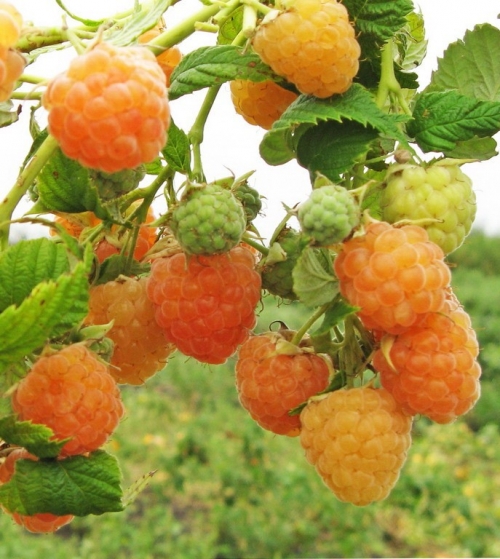
- And here "Cumberland" on the contrary, it produces black berries. The shrub is thorny, has a wax coating. Interestingly, this variety does not produce offspring from the roots and is propagated by the tops of the stems. Raspberry berries of this variety are medium-sized, shiny, almost black or very dark purple in color, taste sweet with a blackberry flavor. The frost resistance of the variety is average. Few affected by diseases and pests.
Some promising varieties of remontant raspberries
Remontant varieties differ from traditional ones in that they can bear fruit twice per season. However, with improper care, the second harvest in August - September turns out to be low both in quantity and quality, since the main forces of the plant will be given to the first harvest in June - July. To prevent this from happening, fertilizing, pruning and regular watering should not be neglected. Many gardeners, saving their time and energy, use remontant species like ordinary raspberries and get only one crop.
- Early summer variety "Persea" bears fruit with large conical dark red berries of sweet and sour taste. The fruits ripen at the same time. The variety easily tolerates a lack of moisture, suffers little from fungal diseases, and is frost-resistant. Approximately the same characteristics have a variety "Sanya" but its tall, upright shoots have slightly drooping tops.

- Raspberry variety " noble" belongs to the middle. There are no thorns on the shoots. The fruit ripening period is extended. It bears fruit with strong red conical berries suitable for transportation.
- The variety bears fruit with large berries of light yellow color "Yellow Giant". The ripening period of the crop is extended. The variety tolerates cold winters well.
- Thornless grade "Kozachka" has a medium late maturity. It has large and medium dark red round berries. The fruits ripen at the same time. The variety is drought tolerant, disease resistant and winter hardy.
- Variety "Patricia" semi-spreading shoots of medium height. Very large conical berries do not break or crumble. This variety is moderately winter-hardy, and is not affected by major diseases.
should be 5.5-6.
Raspberries are moisture-loving, during droughts they need during the formation of fruits and shoots. In the fall, winter moisture-charging watering of raspberries is needed.
on the site should be deeper than 1.5 m, raspberries do not tolerate wetlands and flooded places.
Raspberries "love" potash and nitrogen fertilizers. In the second year after planting, annually in autumn or spring, they add up to 5 kg of humus (compost) per 1 m?, 25 g of double superphosphate, 20 g of potassium sulfate.
With weak growth in early June, raspberries are fed with infusion of manure (5: 1) or bird droppings (12: 1) at the rate of one bucket per five plants. Raspberry repair varieties “carry out” more nutrients from the soil, the doses of fertilizers applied under it double. You can feed raspberries with azofoska, "Ecofoska" or "Kemira" (3 tablespoons per 10 liters of water, 1 liter of solution per 1 bush). Raspberries are usually cuttings, root offspring, layering. Parts of the bush used to propagate raspberries:
1 - lignified root offspring 4 - rooted top of a raspberry shoot Every year, many shoots grow from raspberry rhizomes that will bear fruit next year. You can use these shoots to propagate raspberries, for which they are carefully dug up while they are still 15-20 cm high and transplanted to a new place.
Raspberry propagation by root cuttings is effective. Roots with a thickness of at least 0.5 cm are cut into pieces 20 cm long and planted in grooves. raspberries early spring - before bud germination (during spring planting, raspberries need regular watering for two weeks), autumn - from mid-September to mid-October.
Planting scheme for seedlings: 2 x 0.5 m
0.4 x 0.4 x 0.5 m, raspberry seedlings are not buried when planting, after planting the shoot is cut to 30 cm above the ground.
: raspberry beetle, didimella (purple spot) and others.
Raspberries need support when growing. It is best to grow raspberries on a trellis. This contributes to better lighting of plants, ripening of berries, facilitates soil cultivation and care for raspberry bushes.
When the fruiting stems are tied up, favorable conditions are created for the growth and maturation of new root shoots. For growing raspberries on a trellis, strong poles are installed along each row along its edges, on which wire is fixed in two rows, the lower row at a height of 60-70 cm from the ground, the upper one - 120-150 cm.
Every 5 m, stakes are driven in to support the wire from sagging. Raspberry stalks are evenly (fan-shaped) distributed in different directions and tied to a wire.
If raspberries are grown in one strip (in one row) or the aisles are wide, it is better to pull the wire not in the center of the row, but 30-40 cm away from it, thereby displacing the tied shoots from the center, which provides more Better conditions for the growth of basal stems of raspberries. In autumn (and even better - immediately after harvesting), all fruiting stems, extra root suckers are removed without leaving stumps.
In remontant raspberry varieties, the entire aerial part is removed. In the spring, the frozen tops are cut off to a healthy part. raspberry is carried out in the spring, when it is clearly visible how annual shoots overwintered. The raspberry shoot is shortened to the first well-developed bud.
In addition, pruning the top by 10-15 cm stimulates the formation of new fruit branches in raspberries. On one linear meter of a row of raspberries, 10-15 strong shoots should be left, at least 1.5 m high, growing at a distance of 15-20 cm from each other . Usually, thinning is done in early spring, when frozen shoots are clearly visible, but if thinning is carried out in the summer, when the shoots have reached only 20-25 cm, the stems left develop and ripen better. In August, they pinch the top of it. behind raspberries also consists in regular loosening (shallow!) of the soil around the bushes, the soil around the bushes is especially effective. Raspberries are a low-hardy crop, so its stems are bent down and tied in late autumn.
Double pruning of raspberries according to the Sobolev method
The experience of summer residents suggests that by growing only six raspberry bushes in this way, it is possible to provide a family of four with berries for food and winter preparations.
Preparing the beds and planting raspberries
Any method of growing anything begins with the selection of a site and the preparation of the beds. Raspberry is an unpretentious berry, it can grow well and bear fruit even in the shade, planted along the fence.
But if you want to not just get at least something from the bushes, if the goal is to achieve high yields of raspberries, you will have to tinker with the bed under it. Firstly, it is recommended to place the beds from east to west or from north to south in areas not subject to waterlogging or stagnation of melt water. It is best to plant raspberries along the south wall of the house.
And plant currants in marshy places! Secondly, the garden bed must be fenced with wooden boards or slate in order to raise ten to twenty centimeters above the level of the plot. You can put together a wooden tray following the example of a box for a warm bed.
You can build a kind of "sides" from the ground. This is done to retain moisture during irrigation, so that water flows faster to the roots, and does not drain from the garden. Thirdly, the width of the raspberry bed should be about a meter, the length should be according to the number of bushes, and the distance between individual raspberry bushes should also be equal to a meter .
This is a very important recommendation, unfortunately rarely used by gardeners. Infrequent plantings are both illuminated and blown better, their yield increases, and the likelihood of disease is reduced. The optimal time for planting raspberries is the beginning of autumn.
Raspberries are planted in holes 30-40 centimeters deep, strictly one seedling each. Many summer residents prefer to play it safe, and suddenly it freezes out, does not take root, and they plant almost six shoots in one hole. This is a big mistake.
Several seedlings in one hole are only engaged in the fact that they are fighting with each other for nutrients, thereby reducing the life cycle of the entire bush. After all, at proper fit and subsequent care, raspberries can grow in one place for 20-30 years.
Double pruning raspberries
The next season after planting, raspberries will give the first young shoots (that is, those that have begun to grow this year). So that each of them does not strive to the heights with a bare stick, but begins to grow lateral shoots, the first pruning is carried out.
In late May - early June, the tops of young shoots are cut at a height of 80-100 centimeters. So the bush will not grow too high, it will not lean under the weight of the berries, it will be very convenient to pick them. By the way, for the convenience of harvesting, it’s a good idea to take care of a simple trellis in advance: dig four columns in the corners of the raspberries, and skip at a height of 40-50 centimeters from the ground railings, to which it will then be possible to tie fruit-bearing shoots. The next year, in the spring, a second pruning of raspberries is carried out.
Last year's bushes are now a central stem and several side shoots. It is they who need to trim the tops by another 5-15 centimeters.
After such pruning, the raspberry bush will strive to produce as many seeds as possible, which means throwing out as many flower stalks as possible and tying as many berries as possible. Next to last year's bushes, shoots are again formed current year.
Of these, it is recommended to leave no more than four, the healthiest. The same procedure for the first pruning is carried out with them, and the rest of the young shoots are cut out. It is even better to dig out the strongest shoots and plant them in a new area, separately from the fruit-bearing bushes, and cut the remaining young growth.
With the separate cultivation of fruit-bearing and young bushes, the yield increases incredibly, and the fruiting period of raspberries is extended by 2-2.5 months. That is, an ordinary variety acquires the properties of a remontant variety. In addition, separate cultivation of young and fruiting bushes dramatically reduces the number of raspberry pests.
Watering, fertilizing and mulching raspberries
Having formed a bed for raspberries once, the gardener can be free - it is not necessary to dig up and even loosen the ground under raspberries due to possible damage to nearby roots. In addition to double pruning, raspberry care consists of watering, mulching, fertilizing if necessary, and tying. Raspberries love moist, but not waterlogged soil, so you need to make sure that the soil in the raspberries does not dry out and water the bushes in a timely manner.
And in order not to worry about the lack of irrigation, they use a proven method for years to retain moisture in the soil - mulching. Sobolev himself suggested mulching raspberry beds fresh manure. Cow or horse dung, laid out on the surface of the ridge with a layer of 10-20 centimeters and spilled several times with water, forms a crust that not only retains moisture, but also gradually decomposes, enriching the soil with nutrients.
With such mulching, no top dressing is needed! But in our time, not everyone has the opportunity to purchase so much manure. So we mulch raspberries with everything we can: grass, shavings, peat, sawdust with ash, compost, pulled out weeds, seed husks.
Mulch from several layers of old newspapers, lightly sprinkled with compost, has proven itself well in raspberries. The only condition: the mulch layer next to the bush should not exceed 5 centimeters, so as not to jam the replacement shoots breaking out from under the ground. This is especially true for such heavy material as manure. If you see that, despite mulching, the shoots of the bushes are weak and thin, the leaves twist or change color, spots appear or the edges of the leaves dry out, you can carry out a couple of top dressings with organic fertilizers.
Top dressing from infusion of mullein or chicken droppings with ash works well: a bucket is filled with droppings by a third, filled to the brim with water, mixed and insisted for a couple of days. Then the infusion is diluted with water 1:10 and a glass of ash is added to each bucket of diluted top dressing. For those who grow fruit-bearing bushes along with the shoots of the current year, without separating them, this advice will be very useful: tie the fruit-bearing shoots to the trellis, tilting them.
Having four shoots on each bush, it is easy to tie them two by two to the railing on both sides. This technique will allow last year's and young shoots not to interfere with each other, not to fight with each other for light and air, but to calmly do their job: one - to bear fruit, the other - to grow.
Raspberry shelter for the winter
In autumn, the raspberry shoots that have hatched are cut out completely, and the young ones are carefully bent to the ground, pinned with wooden or metal brackets and covered for the winter. To delay the snow cover, cut shoots of the same raspberries or other thin branches are laid on the raspberries, and the entire structure is covered from above with a thick non-woven fabric, spruce branches, tarpaulins - any warm material at hand. During the winter, raspberries will be covered with snow, which will keep them from freezing. We wish you success and great harvests!
Rules for planting raspberries in the spring. How to choose a seedling? What kind of soil to plant?
Tips for beginners Raspberry is a berry that everyone loves. Plus, it's easy to grow. Only the laziest gardener did not break raspberries in his garden.
Growing these berries, like other fruit crops, includes not only planting, watering, pruning, fertilizing bushes, but also tying, loosening the soil, and removing weeds. Mostly traditional and large-fruited varieties are grown.
However, among them \ there are also those that bear fruit twice a year - remontants. Raspberries are consumed not only fresh, they also taste wonderful raspberry jam, jam, marmalade, jelly and juices. In addition, delicious tinctures, wine and liqueurs are made from raspberries.
Jobs in June
- Drop off at open ground seedlings of cabbage, tomatoes, peppers, cucumbers, zucchini. Watch out for night frosts Thin out planted carrots. It is advisable to do weeding in the rain or in the evening, so as not to attract carrot flies. Thin out the seedlings of cucumbers, leaving the largest ones. During the flowering period fruit trees, raspberries, strawberries, rose hips and currants, make sure that the soil is evenly moistened. After watering, loosen and mulch the soil. Weed the potato beds, loosen the aisles, spud and check for the presence of the Colorado potato beetle and its larvae. You should spray the tomatoes against late blight. sunburn, they should be cleaned of dead bark At the end of the month, re-plant radish, carrots, arugula, lettuce, spinach, dill
Your main criteria when choosing varieties
- Other
Some gardeners prefer remontant raspberry- pruning it is very simple, you do not need to bend the bushes for the winter, and the crop can be harvested twice a season, which is simply impossible in the case of ordinary varieties. But not everything is as wonderful as we would like, and cultivation remontant raspberry has certain disadvantages.
How to grow remontant raspberries and what you need to know for this? ^
Video about repair raspberries
After reading rave reviews on the Internet about the abundance of large, sweet berries that completely cover raspberry bushes in summer and autumn, there is a desire to replace the usual varieties on your site with repair ones. Why not harvest a double crop every year, and even feast on your favorite berry, when the neighbors’ raspberries have long been fruitful! In fact, you have to choose: either harvest the bushes twice, but the berries will be of mediocre quality, or wait for the second, more plentiful fruiting, and enjoy excellent raspberries.
The fact is that the summer harvest weakens the plant, and as a result, the berry ripens much later in the fall, and the berries are small and bony. That's why experienced gardeners they prefer to allocate space in the garden for both remontant and regular varieties in order to pick ripe berries during July, and then also in early autumn. Having figured it out, how to prune remontant raspberries, and providing the bushes with sufficient lighting, moist soil and the necessary top dressing, you can count on a bountiful harvest in the fall. Let it take more effort than it takes regular raspberries, but how nice it is to eat fresh sweet berries from the bushes in September!
Repair raspberry - growing and care according to all the rules ^
Features of caring for remontant raspberries401
In most regions of Russia, the most favorable time for planting remontant varieties is the last ten days of September or the first days of October (just when tulip bulbs are planted). The seedlings planted at this time have time to properly prepare for the winter cold in order to start growing in time in the spring.
It’s not worth planting before, because the root system of seedlings in September is not yet fully formed, which means that raspberries can take root poorly. You can also plant them in early spring by digging seedlings for the winter in an inclined position. Even planting is allowed in May-June, but in this case, the seedlings must be kept under a layer of snow sprinkled with straw or sawdust so that it does not melt longer. In the conditions of a short Russian summer, it is better to choose new ones for growing remontant varieties, which are characterized by rapid growth and precocity. Seedlings of remontant raspberries are planted in rows or separate bushes, as usual, leaving a distance of about one meter between plants. The procedure for planting seedlings does not differ from planting other raspberry varieties: dig shallow holes under the root system, add to the soil fertilizers, install seedlings in pits and tamp the ground. After planting, be sure to water the seedling abundantly.
- Due to the superficial root system, it is not recommended to loosen the ground under raspberries, and in order to avoid the appearance of weeds, the soil must be mulched; remontant raspberries require abundant watering during the season, especially during fruiting; in order for the berries to be large and the harvest rich, the bushes should feed in March complex fertilizers, and before flowering and at the end of autumn fruiting with superphosphate and potassium sulfate; for the prevention of fungal diseases ( powdery mildew, gray rot) can be treated in April with Bordeaux liquid, and biological preparations can be used from pests during flowering.
Deserves special attention pruning shoots, because it largely depends on how good the annual harvest of berries will be.
How to prune remontant raspberries at different times of the year? ^
Fruiting occurs on biennial shoots, as in ordinary varieties, and on annual growth shoots. But since the plant spends too much energy on the ripening of the first crop and on the formation of replacement shoots for the second crop, a special technology for growing remontant raspberries is preferable. In the first year, young shoots grow on the seedlings, which are covered with flowers in July, and berries - in August.
In addition, even in the absence of snowdrifts in winter, hemp can be insulated, and the raspberries will not freeze. In spring, sanitizing the bushes is enough: only those shoots that have frozen or dried out during the winter are cut to the first healthy bud. April is best suited for this procedure, since it is easier to determine which one is healthy by swollen buds. Additionally, in May, you can pinch the tops of the shoots so that the fruiting of remontant raspberries begins later and is longer.
Photo of remontant raspberry bushes on the site, tipsplants.ruPhoto of ripe raspberries on a branch, ogorodsadovod.com Remontant raspberry, 3069-ua.all.biz Rate the article, your opinion is very important. Move the cursor and highlight the desired number of flowers. Benefit:
Raspberries: planting, growing, care
Raspberries have been known to us since ancient times. This berry is loved for its wonderful taste and healing properties. Each of us at least once in our lives tried fragrant raspberry jam with tea.
And you probably heard about the wonderful medicinal properties raspberries. Let's talk about how to get these delicious and healthy berries how to grow raspberries and care for them. Raspberries belong to the rose family.
It is an upright shrub with small thorns. The color of raspberries can vary from light pink to almost black (blackberry varieties of raspberries), there are also yellow raspberries. After planting in the second year, branches will appear on which fruits will grow; in the southern regions of our country, fruits may appear in the first year of planting. Remontant raspberry varieties have now been bred that can produce crops at lower temperatures.
Planting raspberries
If you've already planted shrubs or brambles, planting raspberries won't be much of a hassle. Raspberries are best planted on neutral or slightly acidic soils. For raspberries, you need to take a sunny place with insulation from strong winds, and in winter - with good snow cover.
Make sure that the predecessors of raspberries are not plants similar to it in diseases (tomatoes, strawberries, potatoes). Raspberries are planted in spring, autumn, green cuttings - in summer. They prepare the soil for planting in advance, with autumn planting about a month in advance.
In the spring, prepare a place for landing in the fall (holes, trenches). If you didn’t have time, then in the spring, about 2-3 weeks before you are going to plant.
You can grow raspberries both in separate bushes (at the same time about 10 stems are left on the bush), and in a trellis (tape) way, for this they plant raspberries in a row. In the first case, raspberries are planted in separate holes, in the second - in trenches.
For planting in holes, make holes about 40 cm by 50 cm in size (the same size as the trench), pour the planting mixture into a little mound, moisten the roots in the mullein nutrient solution or the soil solution from the planting mixture, lower the plant into the hole, sprinkle with fertile layer of earth. Between bushes, take a distance of about 1 m, and between rows of about 2 m. The root collar should be a few centimeters above ground level, so that when the ground shrinks completely, it will be at ground level.
It is impossible to deepen too much, this can lead to rotting of the root bud, but a high planting for raspberries is also undesirable. To plant raspberries in a trench, you will need to dig a trench about 45 cm deep and about 50 cm wide.
The number of trenches is equal to the number of rows of raspberries. The distance between rows is taken about 1 m, and between plants - about 40 cm. The trench is filled with nutrient planting mixture.
It should consist of rotted manure, fertile topsoil and mineral fertilizers, double superphosphate will do just fine. Rotted manure or compost can be added to the bottom of the trench with a layer of 15 cm, after which mineral fertilizers and soil, or all components can be mixed.
But if the earth is well moistened (rains), extra watering is not needed. If the buds on the seedling are well developed, cut it off, leaving 30 cm.
Raspberry Care
Watering Raspberries are very fond of watering, but not the bay, so that the roots receive sufficient nutrition, but do not sour. In the spring and summer, a planted raspberry bush especially needs to be saturated with water. pruning
Pruning for raspberries is needed to shorten fruiting shoots and remove thickening and unnecessary root shoots. Fruit-bearing shoots after planting are usually pruned in the spring by about 20 cm.
From the second year, the shoots are shortened every year either after harvesting or already in the spring. After winter, the shoots are cut to a strong bud (about 10 cm). Cut the shoot at the very base.
The first picture shows how to cut the shoots, the second shows how to cut it wrong. Loosening the soil, removing weeds In order not to often dig up the soil, the aisle can be mulched - covered with straw, peat. Bend down raspberry bushes for the winter
Many varieties of raspberries are bent down for the winter so that frost does not damage the shoots, to do this, tilt the bushes to each other and tie them. Garter So that the shoots do not break under the weight of the fruit, they are tied up.
The most common is the fan method, in which two sticks need to be driven between the bushes, and part of the shoots of one bush and part of the shoots of the neighboring one are tied to them at different heights - a kind of fan is obtained. several rows of wire are tied to existing poles, retreating from the center by 35 cm, so that the shoots are slightly inclined in the aisle, and raspberry shoots are already tied to such a wire.
While the seedling is small, it is tied to one row of wire, as it grows, the number of rows of wire is increased. Fertilizer For the best harvest in autumn, fertilize raspberries with organic and mineral fertilizers, wood ash.
Types and varieties of raspberries
In many of our sites you can find 3 types of raspberries:
- traditional raspberries are the hardiest, the harvest is regular, the berries are medium in size, somewhere up to 4 g, but the yield is average. Well adapted to the conditions environment. Lots of root growth
- remontant - brings the largest amount of harvest, berries up to 4 g. Many gardeners cut it after fruiting under the root in order to get it by next autumn big harvest and avoid getting sick. Very winter hardy
- large-fruited raspberries - the fruits of this type of raspberry are larger in shape than those of remontant and famous varieties traditional raspberry. The palatability of large-fruited raspberry varieties is excellent, you can get a lot of harvest and the transportability of many varieties is very good.
Raspberry variety "Apricot" Refers to a remontant species, has a compact, non-spreading bush, berries up to 7 g, yellow and delicate. Resistant to frost, can be grown in many regions of Russia.
Raspberry variety "Malakhovka" The yield of this variety is average, up to 2 kg of berries from a bush, it belongs to the traditional raspberry. The berries are sweet and very tender, with a pronounced raspberry flavor. Fruit size is about 3 g, slightly elongated in shape, with a thin skin and small drupes.
It is well transported, but bushes need to be bent down for the winter. It is affected by gray rot, but the spider mite is not at all terrible for this variety. Raspberry variety "Abundant" The variety belongs to a large-fruited raspberry species, a compact bush, has no thorns, about 5 kg of berries can be collected from a bush.
Berries can grow up to 10 g, berries are elongated, bright red, easily removed, can be transported. The variety is resistant to common diseases, winter-hardy. Refers to dessert varieties.
Raspberry variety "Gusar" This variety has medium-sized bushes about 2 m high, up to 3 kg of berries can be collected from a bush. Berries up to 4 g, bright ruby color, blunt conical shape. Very fragrant bush, practically not susceptible to diseases.
